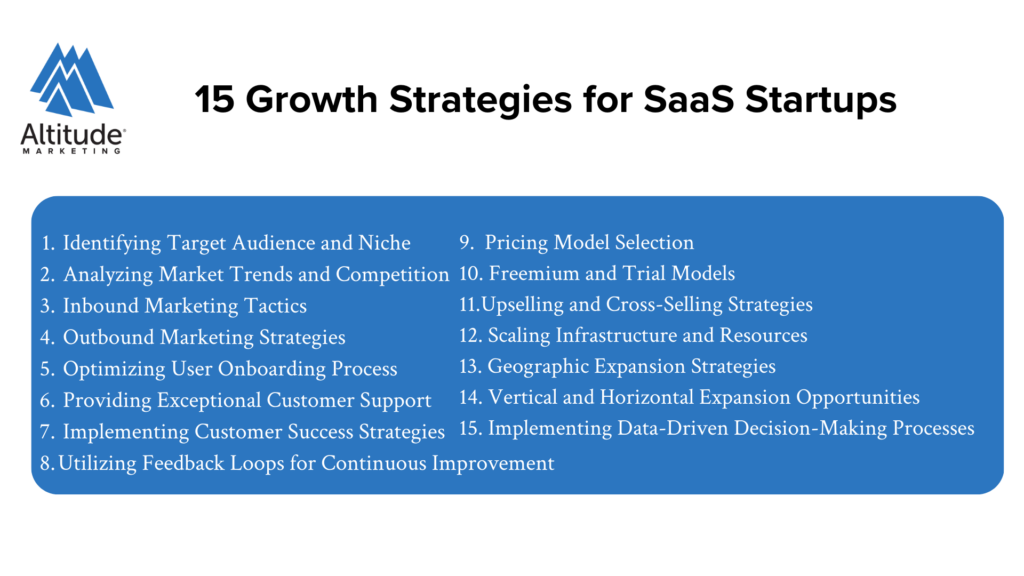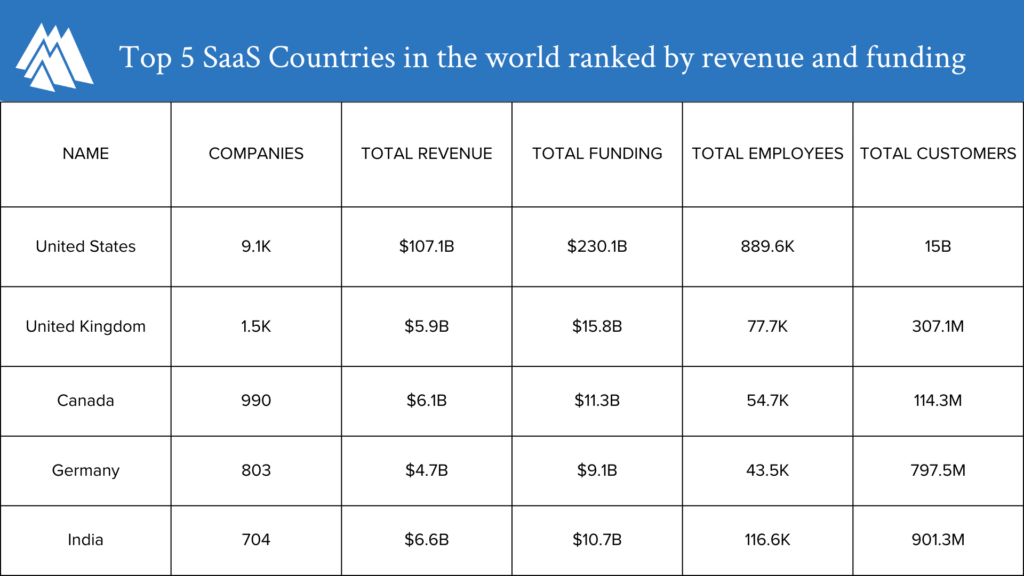The rapid growth of the SaaS industry has reshaped how software is acquired, shifting from traditional models to subscription-based services hosted by providers.
For SaaS startups, growth is essential. In such a competitive space, sustainable growth helps attract investors, secure customers, and drive profits. With the right strategies, SaaS companies can expand their customer base, boost revenue, and build a strong market presence.
Given the dynamic nature of the SaaS landscape, continuous improvement is key to staying ahead of competitors, adapting to market shifts, and seizing emerging opportunities for long-term success.

15 Growth Strategies for SaaS Startups
Definition of SaaS
SaaS, or Software as a Service, refers to a software distribution model where applications are hosted by a third-party provider and made available to customers over the internet. Instead of purchasing and installing software on individual devices, users access SaaS applications through a web browser or API, often on a subscription basis.
This model eliminates the need for customers to manage software infrastructure, updates, and maintenance. These responsibilities are handled by the SaaS provider. Examples of SaaS applications include email services, project management tools, and accounting software.
Key Components of the SaaS Business Model:
- Subscription-Based Pricing: SaaS companies typically charge customers a recurring fee (monthly or annually) for access to their software, based on usage tiers or features.
- Multi-Tenancy Architecture: SaaS applications are designed to serve multiple customers (tenants) from a single instance of the software, allowing for efficient resource utilization and scalability.
- Cloud Infrastructure: SaaS applications are hosted on cloud platforms, providing flexibility, scalability, and accessibility from any device with an internet connection.
- Continuous Updates and Maintenance: SaaS providers are responsible for regularly updating and maintaining their software to ensure security, performance, and feature enhancements.
- Customer Support and Service Level Agreements (SLAs): SaaS companies offer customer support services and SLAs to ensure reliability, responsiveness, and customer satisfaction.
SaaS Growth Strategies

Unlike on-premise solutions, SaaS applications must be designed for scalability, seamless updates, and continuous customer engagement. Additionally, SaaS apps must prioritize performance, security, and user experience to retain customers and minimize churn.
Here are the best growth strategies for your SaaS applications to elevate your business applications and ensure long-term success.
Identify Target Audience and Niche
For better SaaS Growth, it is important to understand your target audience.
Define Ideal Customer Profile (ICP): Start by identifying your perfect customer in detail, including their industry, company size, demographics, and problems they face.
Conduct Market Segmentation: Split the market into groups based on factors like industry or location to find the segments most interested in your product.
Evaluate Niche Opportunities: Look for smaller, specialized groups within the market where your product can stand out and solve specific problems.
Gather Customer Insights: Talk to potential customers through surveys or interviews to learn what they need and how your product can help them.
Validate Target Audience: Use data and feedback to confirm that the groups you’ve identified as ideal customers are interested in your product and align with your business goals.
Analyze Market Trends and Competition
First, look closely at what’s happening in your industry to see what’s popular and what might be on the horizon. This can help you better understand the market.
Then, check out what your competitors are doing – their products, prices, how they advertise, and what customers say about them. This helps you see where you stand compared to them. This degree of market research can uncover and fill previously untapped niches in the market.
Lastly, identify your differentiator. What makes your product different, and why should customers pick yours over the competition? Answering these questions will help you position your company to rise above the competition.
Use Inbound Marketing Tactics
Now that you understand what market gaps your SaaS can fill, it’s time to promote your software. One way to drive brand awareness is through inbound marketing. Inbound marketing aims to organically pull customers towards your business by providing valuable information that addresses their needs and interests. Here are a few inbound marketing tactics you can start with:
- Content Marketing: Create valuable, informative content such as blog posts, whitepapers, case studies, and videos that address your target audience’s pain points and interests. Distribute content through your website, social media channels, and email newsletters to attract and engage potential customers.
- SEO (Search Engine Optimization): Optimize your website and content for relevant keywords and phrases to improve visibility and ranking on search engine results pages (SERPs). Focus on on-page optimization, quality backlinks, and user experience to enhance organic traffic and lead generation.
- Social Media Marketing: Build a strong presence on social media platforms (e.g., LinkedIn and Facebook) to connect with your target audience, share valuable content, engage in conversations, and build brand awareness. Use targeted advertising and sponsored content to reach specific demographics and expand your reach.
Don't Forget Outbound Marketing Strategies
On the other hand, outbound marketing involves reaching out to potential customers proactively to promote products or services. It is a more traditional form of marketing that focuses on pushing messages to a broader audience. These strategies include:
- Email Marketing: Develop targeted email campaigns to nurture leads, promote new content, and drive conversions. Personalize email content based on subscriber preferences and behavior, and utilize automation tools to streamline the process and improve efficiency.
- Cold Outreach: Identify potential prospects through market research and use personalized outreach tactics such as cold emails, LinkedIn messages, and phone calls to introduce your product, establish rapport, and initiate conversations. Focus on providing value and addressing prospects’ needs to increase response rates and conversions.
Optimize the User Onboarding Process
SaaS companies should have an efficient onboarding process that minimizes the initial time investment for users. Software with a more straightforward user onboarding process can be attractive. Below are several key steps to enhance the onboarding process.
- Streamline Registration: Simplify the registration process by minimizing form fields and offering social login options to reduce friction and improve conversion rates.
- Provide Guided Tours and Tutorials: Provide interactive tutorials, guided tours, and tooltips to help new users familiarize themselves with your product’s features and functionality.
- Implement Progressive Onboarding: Gradually introduce users to advanced features and capabilities as they become more familiar with the basics, ensuring a smooth learning curve and preventing information overload.
- Personalize the Experience: Tailor the onboarding experience based on user preferences, goals, and usage patterns to deliver relevant content and recommendations.
- Create a Clear Call-to-Action (CTA): Communicate the next steps and desired actions for users after completing the onboarding process, such as completing a profile, setting up preferences, or exploring key features.
Provide Exceptional Customer Support
If you want your software services to stand out, provide exceptional customer support to your users. Exceptional customer support is essential for SaaS startups to build trust, foster loyalty, and differentiate themselves from competitors.
Here are some key strategies to provide exceptional customer support:
- Increase Response Time: Prioritize prompt responses to customer inquiries and issues to demonstrate responsiveness and commitment to customer satisfaction.
- Arm Your Support Team: Train your support team to have in-depth knowledge of your product and industry best practices to provide accurate, helpful assistance to users.
- Be Proactive: Anticipate and address potential issues or questions before they arise through proactive outreach, monitoring, and communication.
- Make Improvements: Collect feedback from customers about their support experiences to identify areas for improvement and implement changes to enhance the overall support experience.
Implementing Customer Success Strategies
Implementing customer success strategies is crucial for SaaS startups to ensure that their customers achieve their desired outcomes and derive maximum value from their products or service. Here are key steps to effectively implement customer success strategies:
- Customer Onboarding Programs: Develop structured onboarding programs to guide new customers through the initial setup process and ensure a successful implementation of your product.
- Goal Alignment: Work closely with customers to understand their goals, objectives, and desired outcomes, and align your product and services to help them achieve success.
- Regular Check-ins: Schedule regular check-in meetings with customers to review progress, address concerns, and identify opportunities for optimization or expansion.
- Value-added Services: Offer value-added services such as training sessions, workshops, and consulting to help customers maximize the value of your product and achieve their business goals.
- Customer Advocacy Programs: Cultivate a community of satisfied customers who are willing to advocate for your product through testimonials, case studies, and referrals.
Utilize Feedback Loops for Improvement
Software vendors can leverage feedback loops to continuously improve their products and services based on customer feedback and market insights. Here’s how:
- Solicit Feedback: Actively seek feedback from users through surveys, feedback forms, and user interviews to gather insights about their experiences, preferences, and pain points.
- Analyze Feedback: Analyze feedback to identify recurring themes, trends, and areas for improvement. Prioritize changes based on the impact on user satisfaction and retention.
- Use Iterative Product Development: Incorporate user feedback into the product development process to prioritize feature enhancements, usability, and errors to address user needs and pain points.
- Communicate Transparently: Keep users updated on product changes, feature releases, and roadmap adjustments through clear communication channels like release notes, emails, blogs, and newsletters.
- Assess Impact: Track changes in user satisfaction, retention rates, and key performance metrics to gauge the effectiveness of feedback.
Choose a Pricing Model
When selecting a pricing model, consider your customer’s business goals and needs. This will simplify their purchasing decision and enhance clarity. Here are a few models to explore:
Subscription-Based Pricing: Charge customers a recurring fee for access to your SaaS product. This subscription can be on a monthly or annual basis. This model provides predictable revenue streams and encourages customer retention.
Usage-Based Pricing: Price your product based on usage metrics such as the number of active users, data storage, or API calls. This model aligns pricing with value delivered and allows customers to scale usage according to their needs.
Tiered Pricing: Offer multiple pricing tiers with varying features, functionality, and usage limits to cater to different customer segments and willingness to pay. This model allows customers to choose a plan that best fits their needs and budget.
Consider Freemium and Trial Models
Before deciding on a freemium or trial model, think about how your customers engage with your product and what motivates them to convert. The right approach can reduce friction, build trust, and increase adoption. Here are key factors to consider:
- Freemium Model: To attract users and encourage adoption, offer a free basic version of your product with limited features or functionality. Monetize through premium subscription tiers or upsell opportunities, offering additional features, advanced functionality, or premium support.
- Trial Model: Provide a limited-time trial or demo of your product to allow potential customers to experience its full capabilities and benefits. Offer incentives such as discounts, extended trials, or exclusive content to encourage conversion at the end of the trial period. Collect feedback during the trial period to address concerns and improve the user experience. For example, Salesforce offers a 30-day free trial for new users to test their program.
Upselling and Cross-Selling Strategies
Upselling and cross-selling are powerful strategies to maximize customer value and enhance their experience. By understanding their needs and preferences, you can offer relevant upgrades or complementary products that drive higher satisfaction and revenue. These are some upsell and cross sell strategies to consider:
- Feature-Based Upselling: Encourage customers to upgrade to higher-tier plans or premium features by highlighting additional benefits, advanced functionality, and value-added services.
- Usage-Based Upselling: Identify customers who are nearing usage limits or thresholds and upsell them to higher-tier plans or add-on services to accommodate their growing needs.
- Cross-Selling: Recommend complementary products or add-ons to existing customers based on their usage patterns, preferences, and needs to increase customer lifetime value and drive incremental revenue.
- Personalized Recommendations: Use data analytics and machine learning algorithms to personalize upsell and cross-sell recommendations based on individual customer behavior, purchase history, and preferences.
- Promotional Offers: Offer special promotions, discounts, or incentives to encourage customers to upgrade or purchase additional products, such as limited-time offers, bundle discounts, or loyalty rewards.
Scale Infrastructure and Resources
When scaling your infrastructure, it’s essential to align your strategy with both current and future business needs. A well-planned approach ensures you can handle growth seamlessly while maintaining performance and cost-efficiency. Here are key considerations for scaling effectively:
- Cloud Migration: Transition from on-premises infrastructure to cloud-based solutions such as AWS, Azure, or Google Cloud to leverage scalable, flexible, and cost-effective resources.
- Automation and DevOps: Implement automation tools and DevOps practices to streamline development, deployment, and operations processes, enabling faster delivery, improved reliability, and scalability.
- Scalable Architecture: Design and build a scalable architecture that can accommodate growing user bases, increasing data volumes, and fluctuating workloads, utilizing technologies such as microservices, containerization, and serverless computing.
- Capacity Planning: Conduct regular capacity planning assessments to anticipate future resource requirements and scale infrastructure and resources proactively to meet demand without compromising performance or reliability.
Explore Geographic Expansion
Exploring geographic expansion opens up new markets and opportunities for growth. It’s important to understand regional demands, cultural differences, and logistical challenges to ensure a smooth transition. Here are key steps to expanding into new territories:
- Market Analysis: Conduct thorough market research to identify target regions or countries with favorable market conditions, growth potential, and alignment with your product offering.
- Localization: Adapt your product, marketing materials, and customer support to cater to the cultural, linguistic, and regulatory preferences of target markets, ensuring relevance and acceptance.
- Partnerships and Alliances: Form strategic partnerships or alliances with local businesses, distributors, or resellers to facilitate market entry, navigate regulatory requirements, and leverage existing networks and customer relationships.
- Gradual Expansion: Adopt a phased approach to geographic expansion, starting with adjacent or similar markets before targeting more distant or diverse regions to minimize risks and optimize resources.
Pursue Vertical and Horizontal Expansion Opportunities
- Vertical Expansion: Identify opportunities to penetrate new vertical markets or industry segments that can benefit from your product’s features, functionality, or domain expertise.
- Industry Partnerships: Collaborate with industry-specific partners, associations, or organizations to gain insights into vertical markets, access decision-makers, and establish credibility and trust.
- Horizontal Expansion: Explore opportunities to diversify your product offering or extend into adjacent markets or customer segments that complement your existing product and address unmet needs or pain points.
- Product Innovation: Continuously innovate and iterate on your product roadmap to introduce new features, modules, or integrations that expand the scope of your offering and appeal to a broader audience.
Implement Data-Driven Decision-Making
Implementing data-driven decision-making empowers your business to make informed, objective choices based on real insights rather than assumptions. By leveraging accurate data, you can improve efficiency, optimize strategies, and drive better outcomes. Here are key steps to effectively incorporate data into your decision-making process:
- Data Infrastructure: Establish a robust data infrastructure, including data collection, storage, processing, and analysis capabilities, to ensure accessibility, reliability, and scalability of data assets.
- Data Governance: Define clear data governance policies and procedures to ensure data quality, integrity, security, and compliance with regulatory requirements, protecting sensitive information and maintaining trust.
- Data Culture: Foster a data-driven culture within the organization, promoting the use of data and analytics to inform decision-making at all levels, from strategic planning to day-to-day operations.
- Cross-Functional Collaboration: Encourage collaboration between departments and teams to leverage data insights and expertise across the organization, breaking down silos and driving alignment towards common goals.
- Continuous Improvement: Continuously monitor and evaluate the effectiveness of data-driven initiatives, iterating on processes, tools, and methodologies to optimize decision-making and drive business outcomes.
FAQs
What are the advantages of SaaS for startups?
SaaS offers several advantages for startups, including lower upfront costs, scalability, accessibility from anywhere with an internet connection, automatic updates, and simplified maintenance.
How do I choose the right pricing model for my SaaS startup?
Consider factors such as your target market, value proposition, competitive landscape, and customer preferences when choosing a pricing model. Subscription-based, usage-based, and tiered pricing are common options.
How can I scale my SaaS startup effectively?
Scale your SaaS startup by investing in scalable infrastructure and resources, expanding geographically, exploring vertical and horizontal expansion opportunities, and managing growth while maintaining quality.
Final Takeaway
Continuous adaptation and innovation are paramount in the fast-paced SaaS industry, allowing startups to remain agile, responsive, and competitive amidst evolving market dynamics and customer preferences. By embracing a culture of innovation and staying attuned to market trends, SaaS startups can effectively navigate challenges and seize opportunities for long-term success.
Ready to elevate your B2B marketing?
We help leading business-to-business brands hit their marketing goals. Get in touch to learn how Altitude Marketing can help you reach your peak performance.




